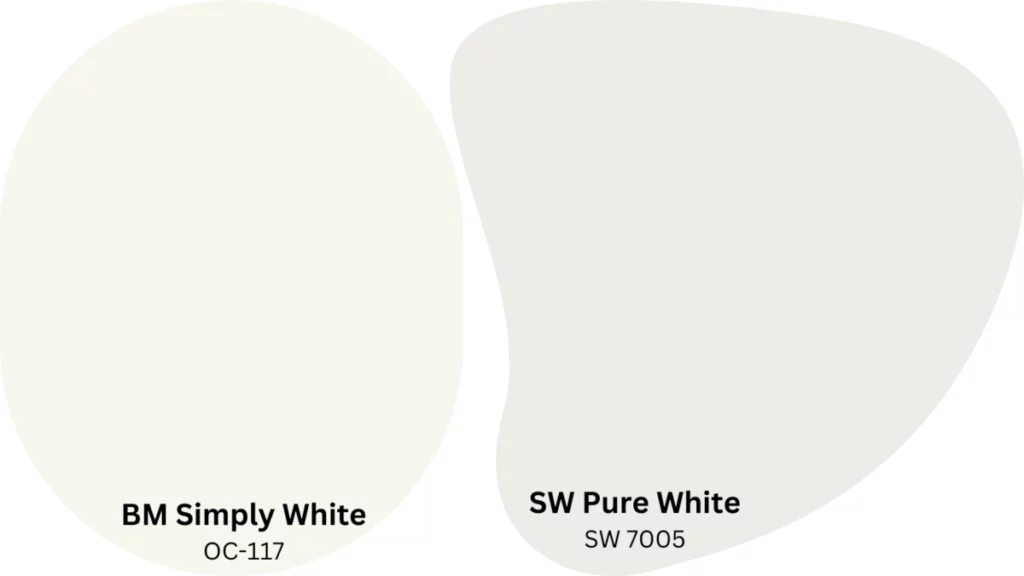A good shade of white paint can make a significant impact on the overall look and feel of a space. Two popular options in the realm of white paint colors are Benjamin Moore’s Simply White and Sherwin Williams’ Pure White. While both paints fall within the white spectrum, their distinct characteristics set them apart.
This comparison will explore ten key differences between Benjamin Moore Simply White and Sherwin Williams Pure White, including color tone, light reflectance value, warmth, versatility, contrast, lighting conditions, undertones in different lighting, application, sheen options, and brand preference.
By understanding these differences, you can make an informed decision and select the white paint that best suits your specific needs and design preferences.

The Differences Between Benjamin Moore Simply White vs Sherwin Williams Pure White
Benjamin Moore Simply White and Sherwin Williams Pure White are two popular paint colors known for their timeless appeal and versatility in interior design. While both shades fall under the category of white, they exhibit distinct characteristics that set them apart. If you want you can read Benjamin Moore Aura vs Sherwin Williams Emerald to get better ideas about these paint colors. Here are ten key differences:
Color Tone
One of the most notable differences between Benjamin Moore Simply White and Sherwin Williams Pure White is their color tone. Simply White has a slightly warmer undertone than Pure White, which gives it a creamier appearance. To learn more about white colors from Benjamin Moore read White Dove vs Decorator’s White.
In contrast, Pure White has a cooler undertone that gives it a purer, crisper white appearance. This difference in color tone can greatly impact the overall look and feel of a room.
Light Reflectance Value (LRV)
Another significant difference between Simply White and Pure White is their light reflectance value (LRV). LRV measures the amount of light a color reflects and ranges from 0 (black) to 100 (pure white).
Simply White has an LRV of 91.7, indicating that it reflects more light and appears brighter than Pure White, which has an LRV of 84.3. This means that Simply White can make a room feel more open and spacious, while Pure White may have a slightly more subdued appearance.
Warmth
The warmth of paint color can greatly impact the mood and ambiance of a room. Simply White has a touch of warmth that makes it an excellent option for creating a cozy, inviting atmosphere. The warm undertones of this paint color can help create a sense of comfort and relaxation in a space.
In contrast, Pure White leans more towards a neutral, cooler tone, giving it a modern and clean look. This cooler tone can create a more formal, sophisticated atmosphere in a room.
Versatility
Both Simply White and Pure White are versatile whites that can work well with a variety of color schemes and design styles.
However, the warmth of Simply White’s undertones may make it more suitable for traditional and warmer color palettes, while Pure White’s cooler undertones can complement contemporary and minimalist aesthetics.
Contrast
The contrast between paint color and other elements in a room greatly influences its overall appearance. Due to its slightly warmer undertone, Simply White may provide more contrast when paired with other colors than Pure White.
This can make it a good choice if you want to create a distinct differentiation between your walls and other elements in the room.
In contrast, Pure White’s cooler undertones may create a more muted contrast with other elements in the room, resulting in a more subtle overall look.
Lighting Conditions
The lighting conditions in a space can greatly impact the appearance of paint color. Simply White adapts well to different lighting conditions, appearing warm and inviting in natural light and maintaining its brightness in artificial light.
Pure White may appear cooler and crisper in natural light but can sometimes appear slightly grayish under certain artificial lighting.
Undertones in Different Lighting
The undertones of paint color can sometimes appear differently under different lighting conditions. In various lighting situations, Simply White may exhibit subtle yellow undertones, enhancing its warm character.
On the other hand, Pure White can reveal subtle blue or gray undertones in specific lighting conditions. Understanding how a paint color’s undertones may appear under different lighting conditions can help you make an informed decision about which color to choose.
Application
Both Simply White and Pure White have excellent coverage and application properties. However, there are some differences in how they apply. Benjamin Moore paints are known for their smooth and easy application, while Sherwin Williams paints are often praised for their durability and long-lasting finish.
Sheen Options
Both Benjamin Moore and Sherwin Williams offer a wide variety of sheen options for their white paints. A room’s overall look and feel can be greatly influenced by these different sheens.
Benjamin Moore provides finishes such as flat, matte, eggshell, satin, semi-gloss, and high-gloss. Sherwin Williams offers similar sheen options, including flat, matte, satin, eggshell, semi-gloss, and high-gloss.
Brand Preference
Ultimately, your preference between Benjamin Moore and Sherwin Williams may come down to personal preference. While both brands are known for their quality products, the specific factors that matter the most to you may vary.
This could include factors such as availability in your area, personal experience with the brand, or specific color preferences.
Comparison Table of Benjamin Moore Simply White vs Sherwin Williams Pure White:
| Features | Benjamin Moore Simply White | Sherwin Williams Pure White |
|---|---|---|
| Color Tone | Slightly warmer | Cooler |
| Light Reflectance Value (LRV) | 91.7 | 84.3 |
| Warmth | Cozy and inviting | Modern and clean |
| Versatility | Suitable for warmer palettes | Complements contemporary aesthetics |
| Contrast | Provides more contrast | Subtle contrast |
| Lighting Conditions | Adapts well to different lighting | Crisper in natural light |
| Undertones in Different Lighting | Subtle yellow undertones | Subtle blue or gray undertones |
| Application | Smooth application | Durable and long-lasting |
| Sheen Options | Flat, matte, eggshell, satin, semi-gloss, high-gloss | Flat, matte, satin, eggshell, semi-gloss, high-gloss |
Discover the Perfect White Paint for Your Space
The choice between Benjamin Moore Simply White and Sherwin Williams Pure White ultimately comes down to personal preference and the specific requirements of your project. While Simply White offers a slightly warmer undertone and higher light reflectance value, Pure White boasts a cooler tone and unique qualities.
Consider the overall aesthetic you wish to achieve, the lighting conditions in your space, and how the white paint will interact with other colors and elements. Additionally, consider factors like application properties, available sheen options, and brand loyalty when deciding.
Remember to test samples in your space to see how they perform in different lighting situations. Benjamin Moore and Sherwin Williams are renowned paint brands that ensure quality products. Ultimately, selecting the right white paint will help you create the desired atmosphere and elevate the overall look of your space.

S. Pushon is a paint expert, self-taught artist, and currently working as an adviser in the paint industry as a Quality Improvement and Development Assistant.
An artist by heart, he draws remarkable art pieces and as a professional paint industry individual, he seeks the insight and shares with enthusiasts. Read more…
